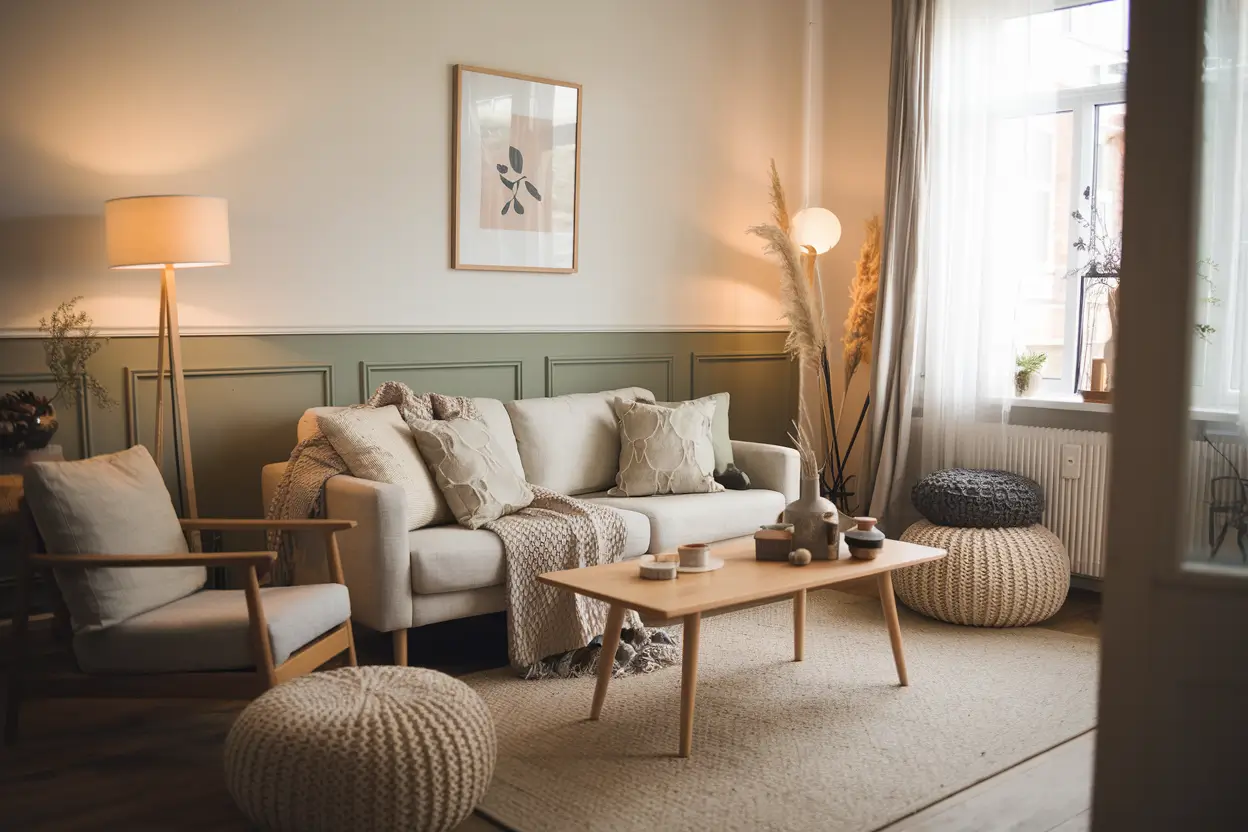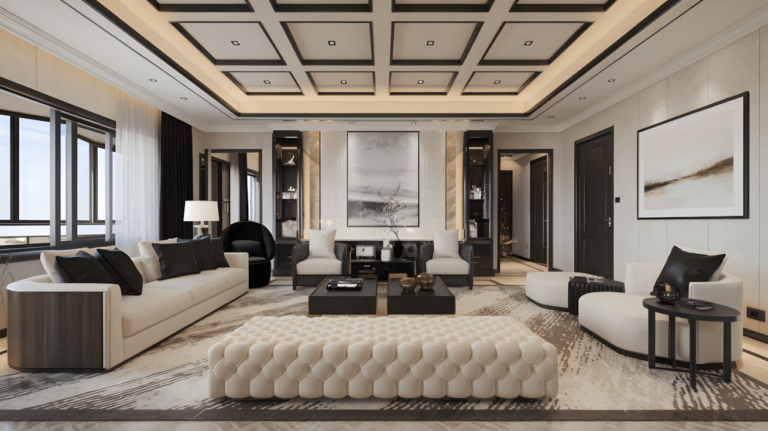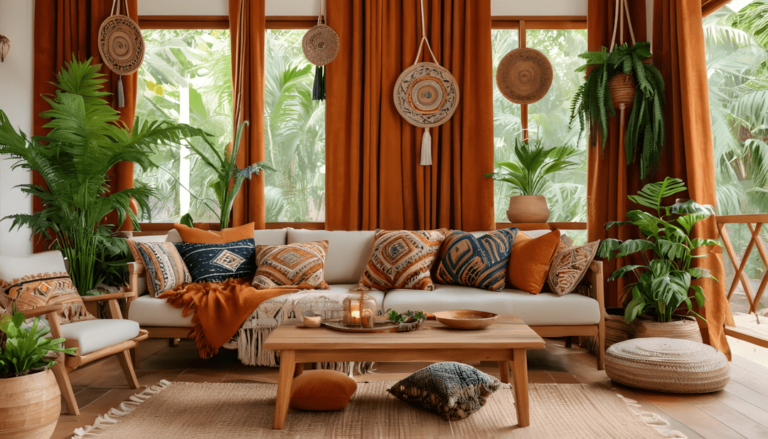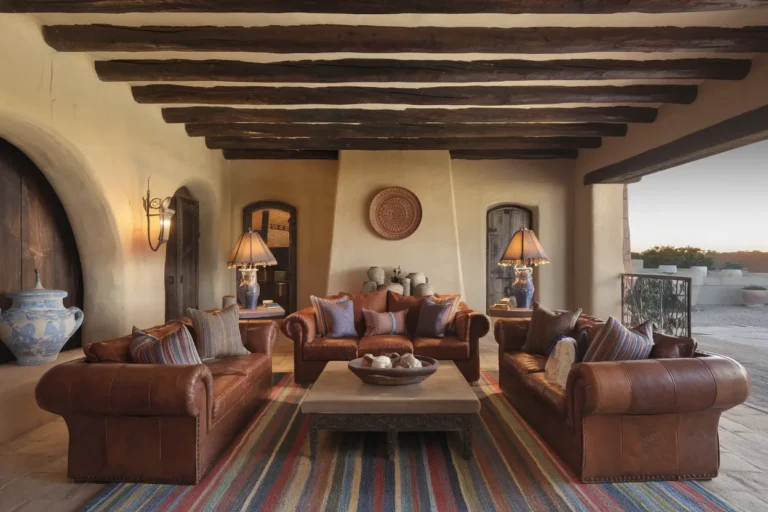Picture walking into a living room that instantly makes you want to curl up with a good book and a steaming cup of coffee. The space feels effortlessly elegant yet incredibly welcoming, with clean lines that somehow never feel cold or sterile.
This is the magic of Scandinavian design—a philosophy that proves luxury doesn’t require a luxury budget.
After spending three years transforming my own cramped apartment using Nordic design principles, I’ve discovered that creating an authentic Scandinavian living room has more to do with understanding the core philosophy than purchasing expensive Danish furniture.
The secret lies in embracing “lagom”—the Swedish concept of having just the right amount—and “hygge,” Denmark’s approach to cozy contentment.
In this guide, you’ll learn the exact strategies I used to achieve that coveted Scandinavian aesthetic for under $800, along with professional techniques that interior designers charge thousands to implement. Whether you’re working with a studio apartment or a spacious family room, these principles will help you create a space that embodies Nordic serenity without breaking your budget.
Understanding Authentic Scandinavian Design Philosophy
True Scandinavian design emerged from practical necessity in countries where winters are long and natural light is precious. This isn’t just an aesthetic choice—it’s a lifestyle philosophy that prioritizes functionality, comfort, and connection with nature.
The foundation rests on three core principles that cost nothing to implement: maximizing natural light, embracing minimalism with purpose, and creating warmth through texture rather than clutter.
In my experience, many people mistakenly think Scandinavian means “stark white everything,” but authentic Nordic spaces balance that brightness with rich textures and carefully chosen warm elements.
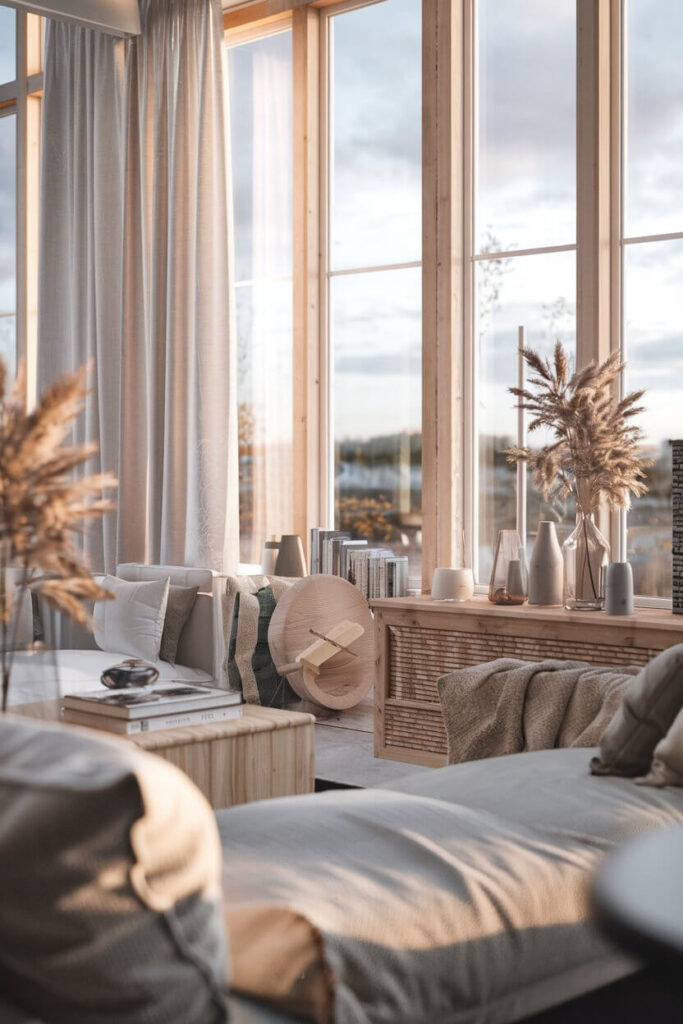
Consider how Scandinavians approach their homes during those endless winter months. Every element serves a dual purpose: beautiful and functional.
A wooden bowl isn’t just decoration—it holds fresh fruit or serves as a catch-all for keys. This purposeful approach means you’ll actually spend less money because every purchase needs to earn its place.
The color palette naturally flows from this practical foundation. While white and light grays dominate to reflect precious natural light, these are anchored by warm wood tones and punctuated with muted blues, sage greens, or soft terracotta—colors borrowed directly from the Nordic landscape. I’ve found that starting with this natural color foundation prevents costly decorating mistakes down the road.
Pro tip: Before buying anything, spend a week observing how natural light moves through your space throughout the day. This observation will guide every decision you make, from paint colors to furniture placement, ensuring your budget works as efficiently as possible.
Strategic Color Palette and Paint Selection
Your paint choices will make the biggest visual impact for the smallest investment, typically running $50-$150 for an entire living room transformation.
The key is understanding that Scandinavian white isn’t stark contractor white—it’s carefully selected warm whites that work with your specific lighting conditions.
Start with your largest wall surfaces using colors like Benjamin Moore’s Cloud White or Sherwin-Williams’ Alabaster for spaces with abundant natural light.
If your room faces north or receives limited sunlight, opt for slightly warmer alternatives like Benjamin Moore’s White Dove, which prevents that cold, institutional feeling that kills the hygge atmosphere you’re trying to create.
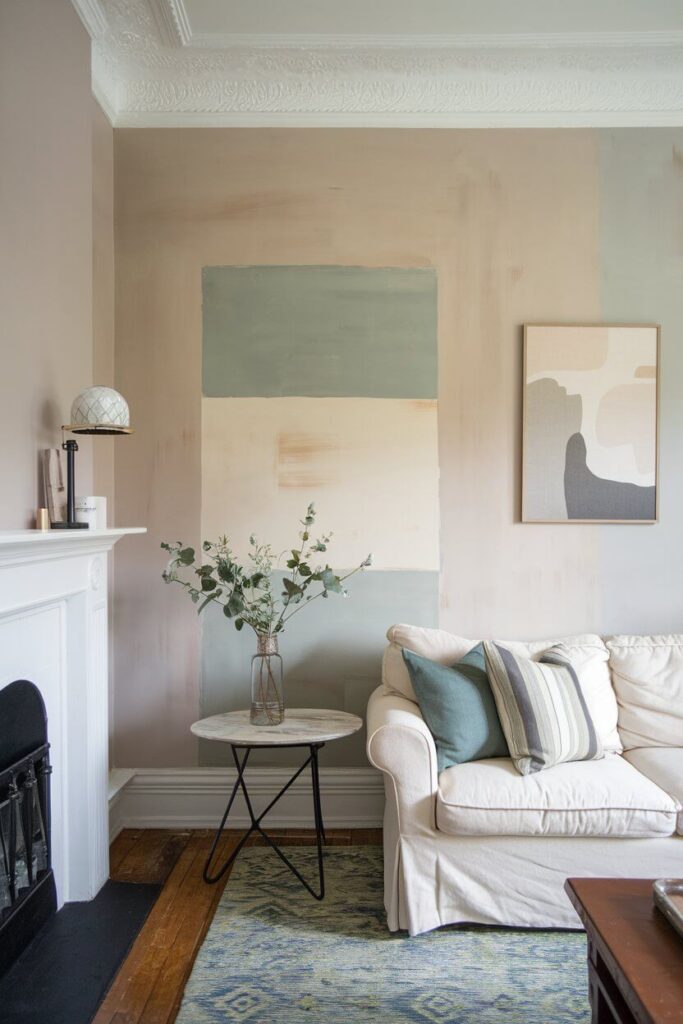
I learned this lesson the hard way when I first painted my living room in pure white, only to discover it felt like a dentist’s office during cloudy days.
The $40 I spent on a test quart of a warmer white saved me from repainting the entire room and completely changed how the space felt during those crucial evening hours.
For accent walls or architectural details, consider soft, muted tones that reflect Nordic landscapes. Sage green works beautifully behind a reading nook, while a gentle blue-gray can define a seating area without creating harsh divisions. These colors should whisper rather than shout—think morning mist rather than bold statements.
The ceiling often gets overlooked, but painting it the same soft white as your walls creates that seamless, cocoon-like feeling characteristic of Scandinavian interiors. This technique costs no extra money but makes rooms feel larger and more cohesive.
Money-saving strategy: Many paint stores offer mis-tinted paint at significant discounts. Since Scandinavian colors tend to be subtle and forgiving, you can often find perfect shades for $5-$15 per gallon instead of $50-$70. Just ensure the undertones work with your lighting before committing to large quantities.
Budget-Friendly Furniture Selection and Arrangement
Scandinavian furniture prioritizes clean lines and natural materials, which means you can achieve the look through smart shopping rather than expensive designer pieces. The key is understanding proportions and focusing on a few quality pieces rather than filling every corner.
Start with seating that embodies Nordic principles: low-profile sofas or sectionals in neutral fabrics like linen-look materials or soft cotton blends. Avoid overstuffed, bulky pieces that overwhelm the space.
I found my perfect sofa at a discount furniture outlet for $400—a simple, light gray piece with wooden legs that looks remarkably similar to designs costing $2,000 at high-end stores.
Coffee tables should be functional and unobtrusive. Light wood tones work beautifully, but if solid wood exceeds your budget, look for well-made laminate pieces with clean lines. The trick is choosing pieces where the proportions feel right rather than focusing solely on materials.
A $150 coffee table with perfect scale will look more expensive than a $500 piece that’s too large or ornate for the space.
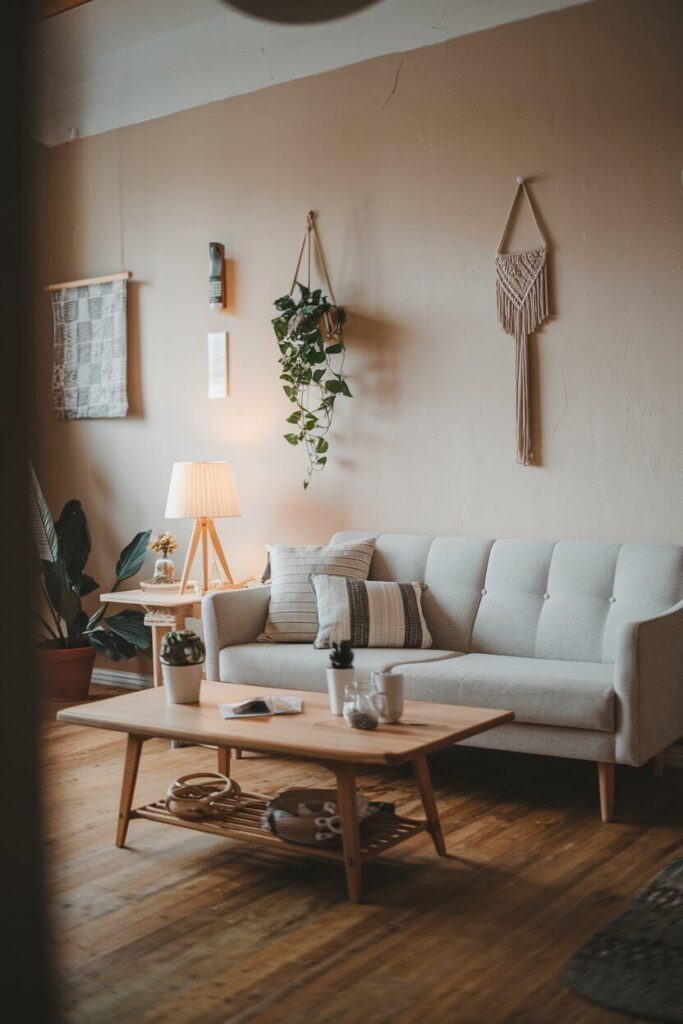
Storage becomes decoration in Scandinavian design. Instead of hiding everything away, choose beautiful storage pieces that serve double duty. Woven baskets, wooden crates, or simple floating shelves provide necessary organization while adding texture and visual interest.
I use vintage wooden apple crates as both storage and side tables—each one cost $15 at a flea market and adds authentic character.
Lighting deserves special attention since it’s crucial for creating hygge. Instead of overhead fixtures that create harsh shadows, invest in table lamps and floor lamps with warm LED bulbs.
Thrift stores often have lamp bases that just need updating with new shades. For $30-$50, you can create lighting that rivals expensive designer fixtures.
Space planning tip: Arrange furniture to create conversation areas rather than pushing everything against walls. This approach costs nothing but makes your space feel more intimate and purposeful—hallmarks of authentic Scandinavian living.
Textiles and Accessories That Create Hygge
The magic of Scandinavian coziness lives in the layers of texture you add through textiles and carefully chosen accessories. This is where you can achieve maximum impact with minimal investment, typically spending $200-$300 to completely transform your space’s comfort level.
Natural fiber textiles form the foundation of Nordic comfort. Chunky knit throws in cream or soft gray instantly add that hygge factor to any seating area. While authentic wool pieces can be expensive, cotton or cotton-blend alternatives provide similar visual appeal at a fraction of the cost.
I’ve found beautiful throws at discount retailers for $25-$40 that achieve the same cozy effect as $150 designer versions.
Pillows offer the easiest way to introduce subtle color and additional texture. Mix different materials—linen, cotton, maybe one faux fur piece—while staying within your established color palette. The key is varying textures rather than colors, creating visual interest through tactile diversity rather than busy patterns.
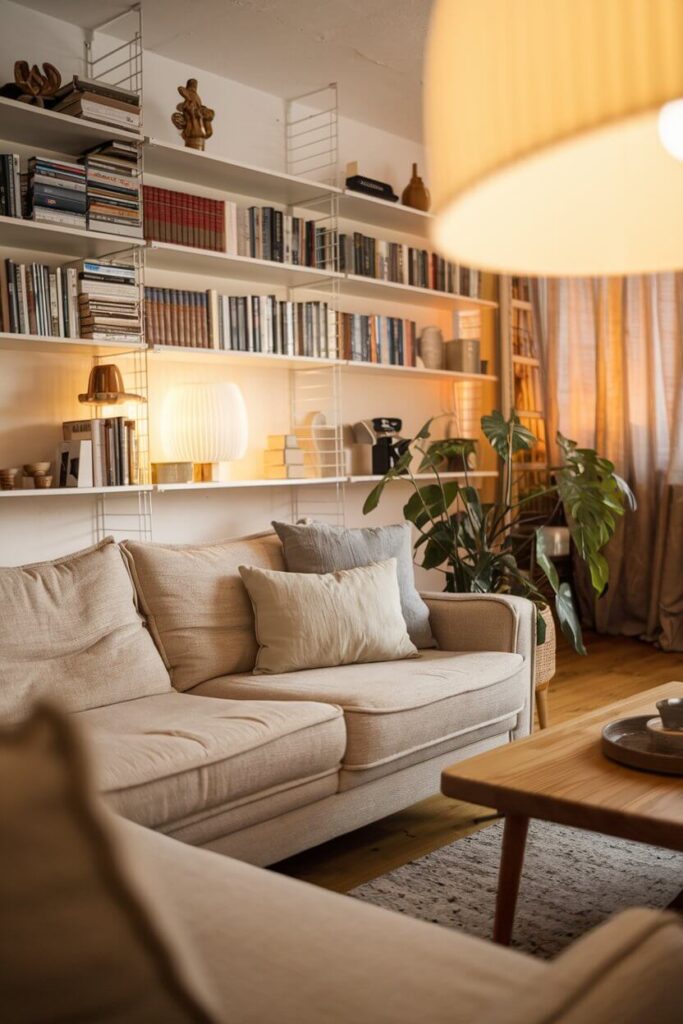
Area rugs ground your seating areas and add crucial warmth to what might otherwise feel like cold floors. Natural fiber rugs like jute or sisal work perfectly and cost significantly less than wool alternatives.
For my living room, a large jute rug cost $120 and provides that essential foundation for the entire seating arrangement.
Curtains or window treatments should maximize natural light while providing privacy when needed. Simple linen or linen-look panels hung close to the ceiling and extending to the floor make windows appear larger and more dramatic. This costs around $50-$80 per window but creates a custom, high-end appearance.
Greenery brings life to Nordic spaces, but choose plants that thrive in your specific lighting conditions. Snake plants, pothos, or peace lilies work well in lower light, while fiddle leaf figs or rubber plants flourish with more sun. Simple planters in natural materials like terracotta or white ceramic maintain the clean aesthetic while adding vital organic elements.
Budget hack: Create your own artwork using natural materials. Pressed leaves in simple frames, branches arranged in tall vases, or even beautiful stones collected from nature walks provide authentic Nordic touches that cost nearly nothing but feel deeply personal and connected to the natural world.
Lighting Design for Year-Round Coziness
Scandinavian lighting philosophy recognizes that artificial light needs to compensate for months of limited daylight while creating the intimate atmosphere essential to hygge. Your lighting strategy should include multiple sources at different levels, creating flexibility for various activities and moods throughout the day.
Layer your lighting starting with ambient sources that provide general illumination. Instead of relying solely on overhead fixtures, which can feel harsh and institutional, use table lamps and floor lamps with warm-toned LED bulbs (look for 2700K-3000K color temperature). These create pools of gentle light that make spaces feel welcoming rather than clinical.
Task lighting becomes particularly important in Nordic design since natural light may be limited for much of the year.
Reading lamps beside seating areas, under-cabinet lighting in any built-in shelving, or even string lights used thoughtfully can provide necessary functionality while maintaining the cozy atmosphere.
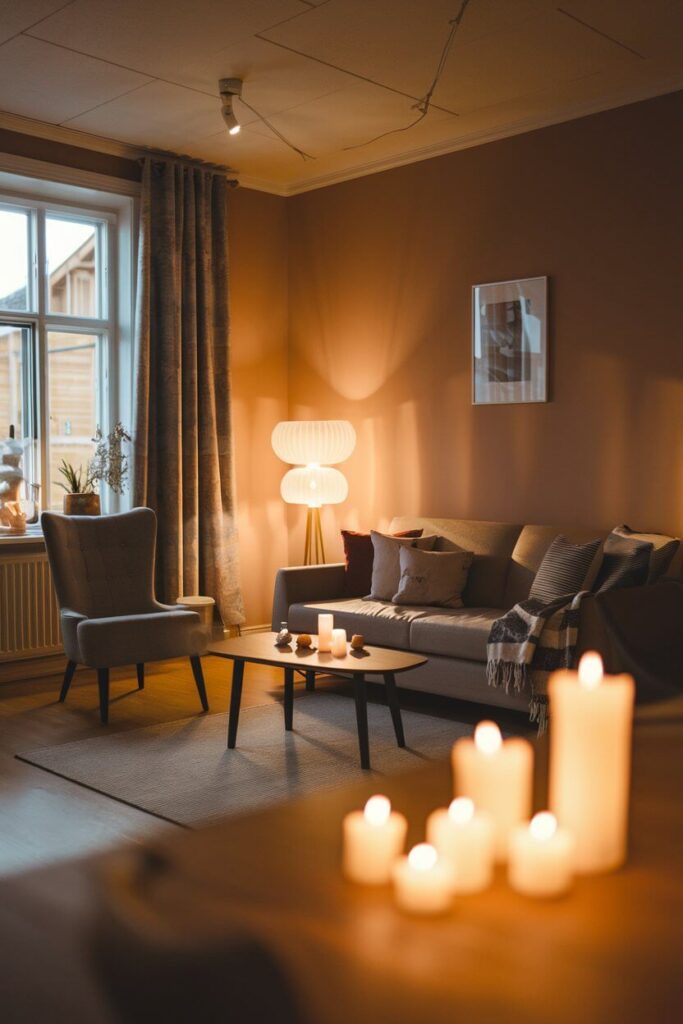
Candles represent the heart of hygge lighting. Real candles provide unmatched ambiance, but LED alternatives offer safety and convenience for everyday use. Group candles of varying heights on your coffee table, mantel, or floating shelves to create instant warmth and atmosphere.
I keep battery-operated pillar candles that I can turn on every evening, creating consistent coziness without the worry of open flames.
Natural light enhancement costs nothing but makes an enormous difference. Keep window treatments minimal during daylight hours, position mirrors to reflect available light deeper into your space, and choose light-colored surfaces that bounce illumination around the room rather than absorbing it.
Professional tip: Create a lighting schedule that transitions your space from bright, energizing light during active hours to warm, dim lighting as evening approaches. This mimics natural circadian rhythms and helps create that distinctly Nordic sense of seasonal comfort.
Storage Solutions That Double as Decor
Scandinavian design celebrates the beauty of functional storage, turning necessary organization into attractive design elements. This approach helps maintain the clean, uncluttered aesthetic while providing practical solutions for real-life living—all without requiring expensive built-in features.
Open shelving displays your most attractive belongings while keeping everyday items organized and accessible. Floating shelves in light wood or white finishes provide display space for books, plants, and carefully chosen objects. The key is editing ruthlessly—each item should either be beautiful, functional, or ideally both.
Baskets become essential tools for managing visual clutter while adding natural texture to your space. Woven baskets can hold throw pillows when not in use, magazines, children’s toys, or any items that need to be quickly tidied. Choose baskets in natural materials and neutral colors that complement rather than compete with your established palette.
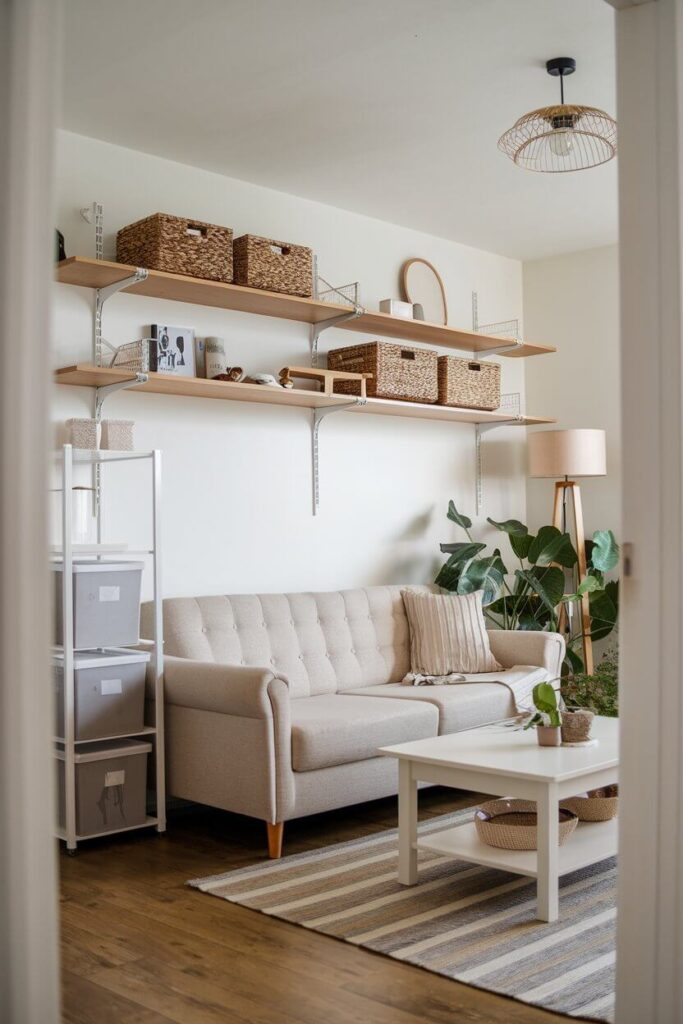
Multi-functional furniture maximizes both your budget and your space. Ottoman storage cubes provide seating, surface space, and hidden storage for less than $100. A console table behind your sofa creates a display surface while hiding less attractive items in drawers or baskets underneath.
Vintage furniture often provides better storage solutions at lower prices than new pieces. Mid-century credenzas, old wooden trunks, or antique armoires can serve as media centers, general storage, or room dividers while adding character that new furniture lacks. I found a beautiful 1960s credenza for $180 that would cost over $800 new and provides storage for electronics, games, and seasonal items.
Organization philosophy: Embrace the concept of “a place for everything and everything in its place.” This Swedish approach to organization means taking a few minutes each day to return items to their designated homes, maintaining that serene, uncluttered feeling that makes Scandinavian spaces so appealing.
Plant Selection and Natural Elements
Nordic design draws heavily from the natural world, bringing outdoor elements inside to create connection with nature even during harsh winter months. Plants and natural materials provide essential life and organic texture that prevents minimalist spaces from feeling sterile or cold.
Choose plants that thrive in your specific conditions rather than struggling to keep Instagram-famous varieties alive. Snake plants, ZZ plants, and pothos handle lower light beautifully and forgive occasional neglect—perfect for maintaining that effortless Scandinavian vibe.
For brighter spaces, consider rubber trees, fiddle leaf figs, or monstera plants that make dramatic statements while purifying indoor air.
Natural materials throughout your space reinforce the connection to Nordic landscapes. Wooden bowls, stone coasters, woven plant hangers, or even interesting pieces of driftwood become decorative elements that cost little but add authentic organic texture. These materials age beautifully, developing character over time rather than looking worn out.
Seasonal elements help your space evolve throughout the year, maintaining interest without requiring major purchases.
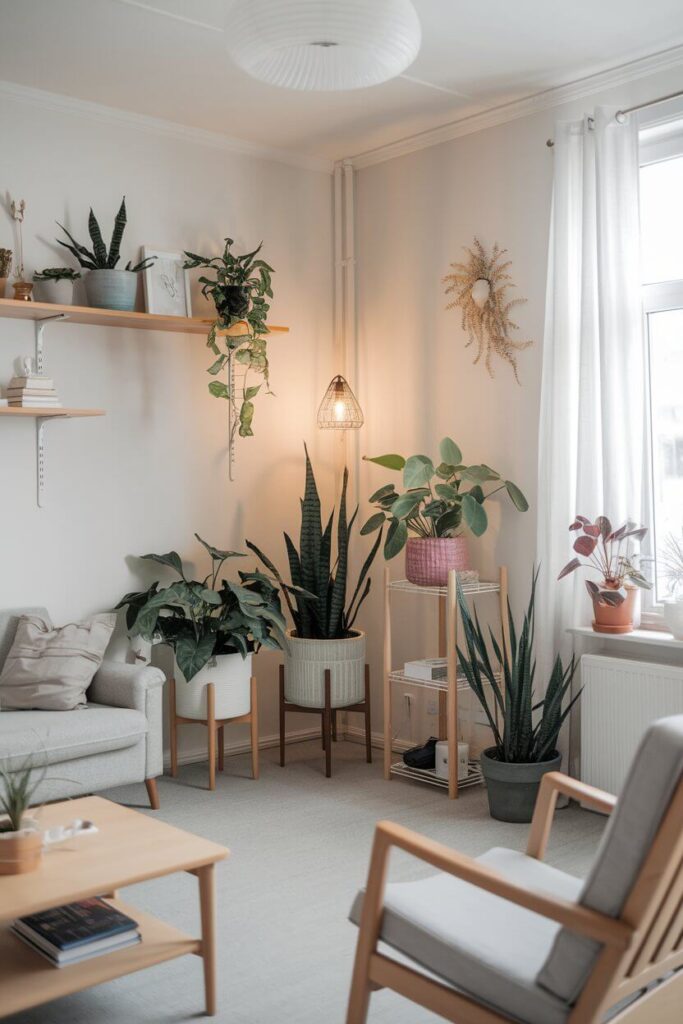
Branches with spring buds, summer wildflowers, autumn leaves, or winter evergreen sprigs bring the changing seasons indoors while providing fresh focal points that cost almost nothing.
Group plants at different heights to create visual interest and make your collection feel more substantial. A large floor plant, medium-sized table plant, and small hanging or shelf plant create layers that add depth to corners or empty wall areas.
Care strategy: Start with one or two easy-care plants and expand your collection gradually. Success with simple plants builds confidence and helps you understand your space’s growing conditions before investing in more demanding varieties.
Bringing It All Together: Final Styling Tips
The final step in creating your budget-friendly Scandinavian living room involves styling and refining the space to achieve that effortless, lived-in feeling that characterizes authentic Nordic design. This process costs nothing but makes the difference between a room that looks decorated and one that feels naturally evolved.
Edit your accessories ruthlessly, following the principle that every visible item should serve a purpose or bring you genuine joy. This doesn’t mean bare surfaces, but rather thoughtfully curated displays that feel intentional rather than cluttered.
Group objects in odd numbers, vary heights and textures, and leave plenty of breathing room between elements.
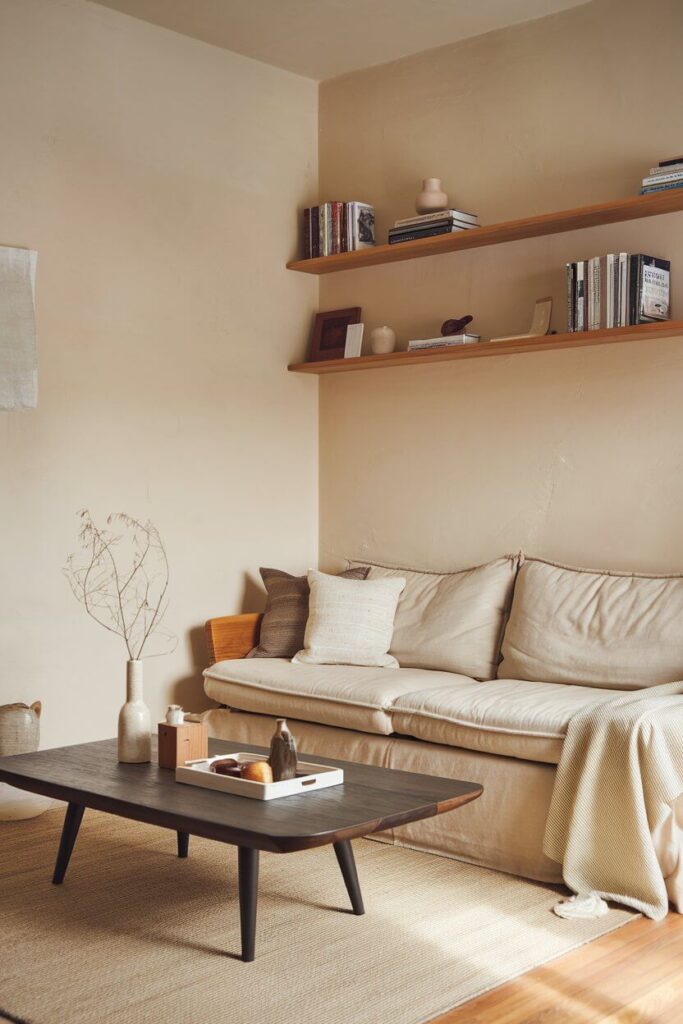
Create vignettes that tell stories about your life and interests. A stack of beautiful books, a simple ceramic mug, and a small plant on your coffee table suggests quiet mornings with coffee and reading. These personal touches make your space feel authentic rather than showroom-perfect.
Pay attention to negative space—the empty areas that allow your eyes to rest. Scandinavian design celebrates these quiet moments between objects, so resist the urge to fill every surface or corner. Sometimes the most powerful design element is what you choose not to include.
Maintain flexibility in your arrangements, moving accessories seasonally or when you need a fresh perspective. The beauty of budget-friendly decorating is that you can experiment and change without significant financial investment.
Final reality check: Step back and ask yourself if the space feels like somewhere you’d want to spend a quiet evening. If something feels off, trust that instinct and make adjustments. Authentic Scandinavian design prioritizes how a space feels over how it looks in photographs.
Conclusion: Your Path to Nordic Serenity
Creating a cozy Scandinavian living room on a budget isn’t about copying expensive showrooms—it’s about understanding the principles behind Nordic design and adapting them to your space, lifestyle, and financial reality. The philosophy of lagom teaches us that having “just enough” often creates more satisfaction than having everything.
Start with paint to establish your foundation, invest in a few key furniture pieces that serve multiple purposes, and build layers of comfort through textiles and plants.
Remember that authentic Scandinavian style develops over time, with each element chosen thoughtfully rather than purchased impulsively.
The $800 budget I mentioned at the beginning covers the major elements—paint, key furniture pieces, textiles, and plants—but the real magic happens through the daily choices you make about how to live in and care for your space.
The Nordic approach to home isn’t just about aesthetics; it’s about creating a sanctuary that supports your well-being throughout the year.
Your Scandinavian living room will be uniquely yours, reflecting your personal needs and preferences while embracing the timeless principles of simplicity, functionality, and connection to nature. Trust the process, make changes gradually, and enjoy creating a space that truly embodies the spirit of hygge—that sense of cozy contentment that makes home the place you’re always happy to return to.

